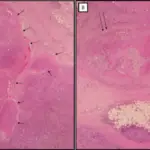Duct ectasia is a disorder of the extralobular ducts which is characterized by different degrees of periductal inflammation, periductal fibrosis, and duct dilatation.
What is the Pathology of Duct Ectasia?
The pathology of duct ectasia is:
-Etiology: The cause of duct ectasia is not well known. Possible causes may include smoking, hyperprolactinemia, and phenothiazine treatment.
-Pathogenesis: The sequence of events that lead to duct ectasia is the stasis caused by duct obstruction which is the inciting cause of duct inflammation with further obstruction.
-Morphology: The morphology associated with duct ectasia shows firm fibrotic breast tissue with prominent dilated and the thick walled ducts filled with a tan-white, beige, or granular secretions. Calcifications with abscess formation may also be present.
-Histology: The histology associated with duct ectasia shows duct dilation with foamy histiocytes within the luminal secretions and infiltrating the wall of the involved ducts.
How does Duct Ectasia Present?
Patients with duct ectasia are typically older females. The symptoms, features, and clinical findings associated with duct ectasia include pain, nipple discharge which can be clear, cloudy, or bloody and the nipple retraction which is worm-like doughy palpable mass beneath the nipple.
How is Duct Ectasia Diagnosed?
Duct ectasia is diagnosed by biopsy.
How is Duct Ectasia Treated?
For many women mammary duct ectasia resolves on its own with no treatment and some women find that simple care, like warm compresses applied to the breast, is enough to manage symptoms. Duct ectasia may be treated by surgery.
What is the Prognosis of Duct Ectasia?
The prognosis of duct ectasia is good. If it’s left untreated a bacterial infection causing duct ectasia may cause more widespread infection and tissue damage, but mammary duct ectasia doesn’t increase the risk for breast cancer.



